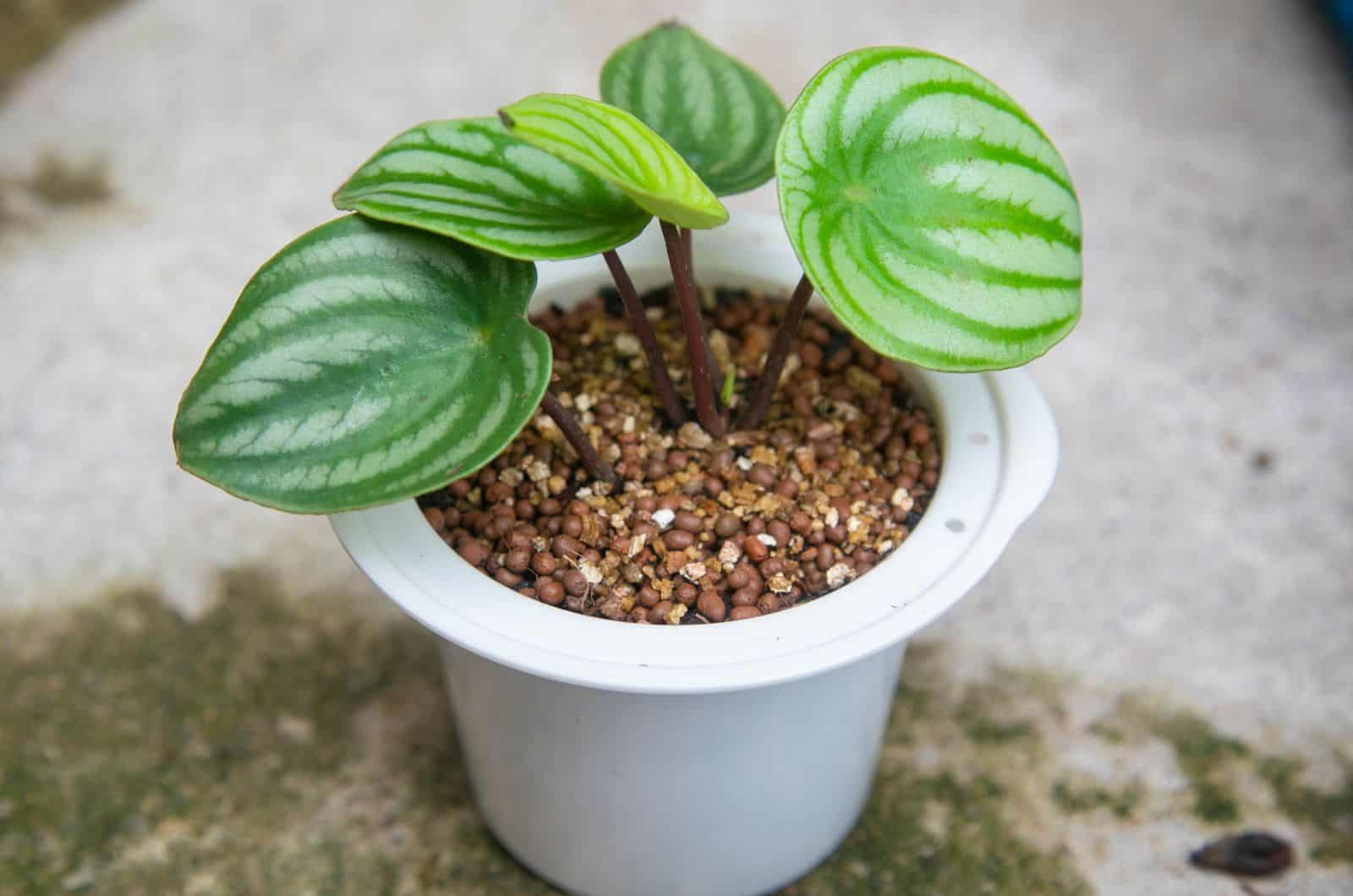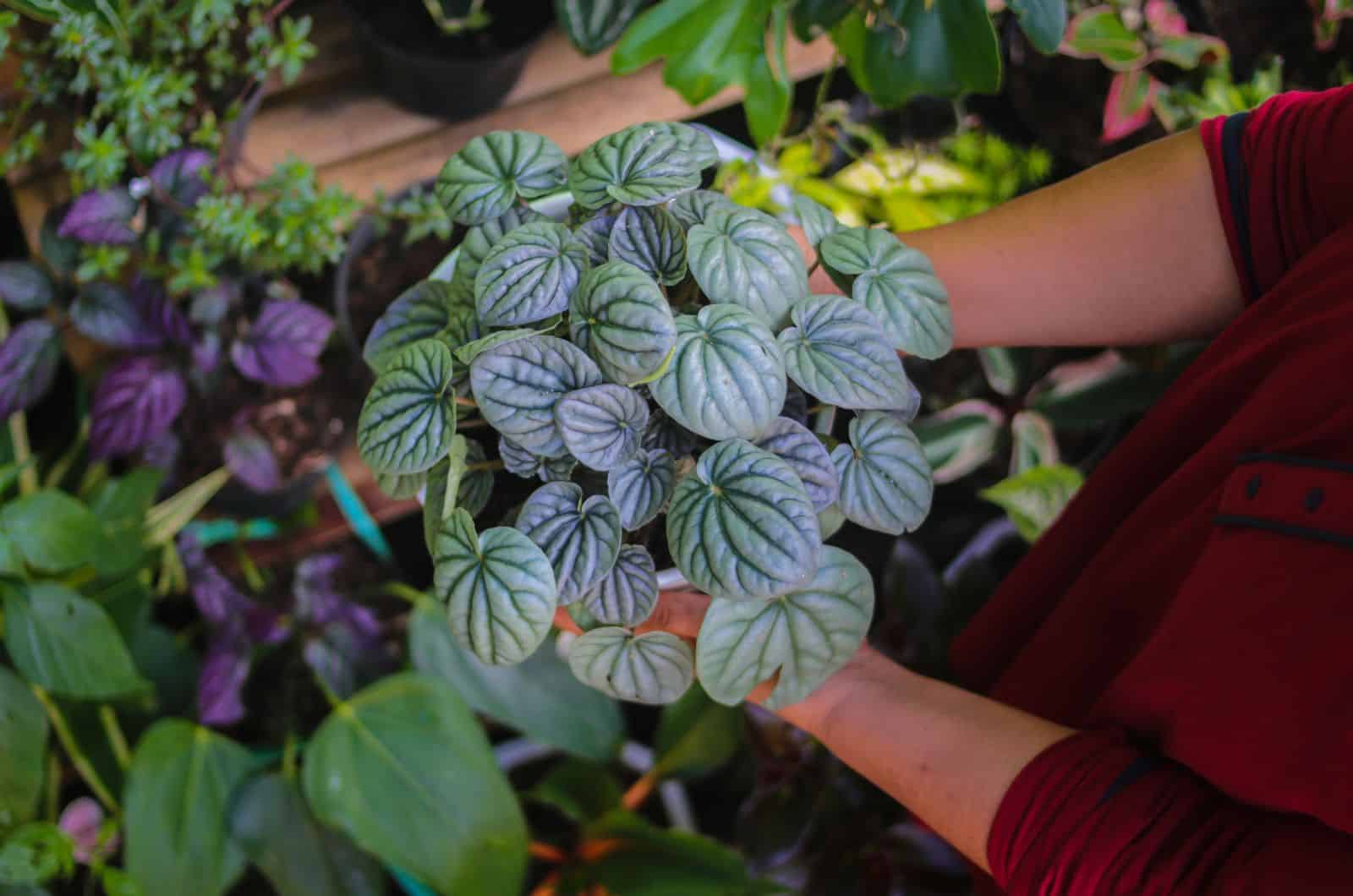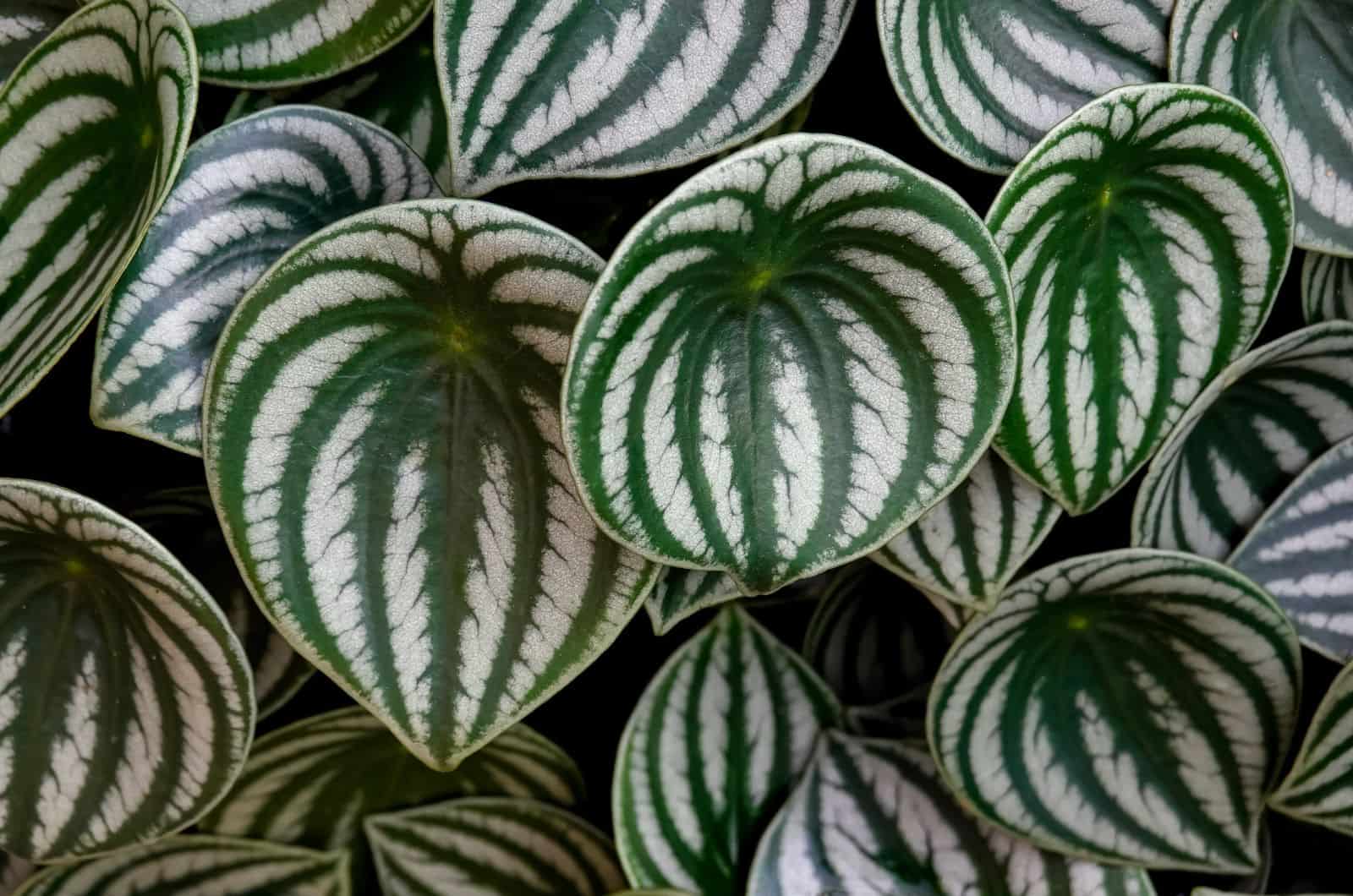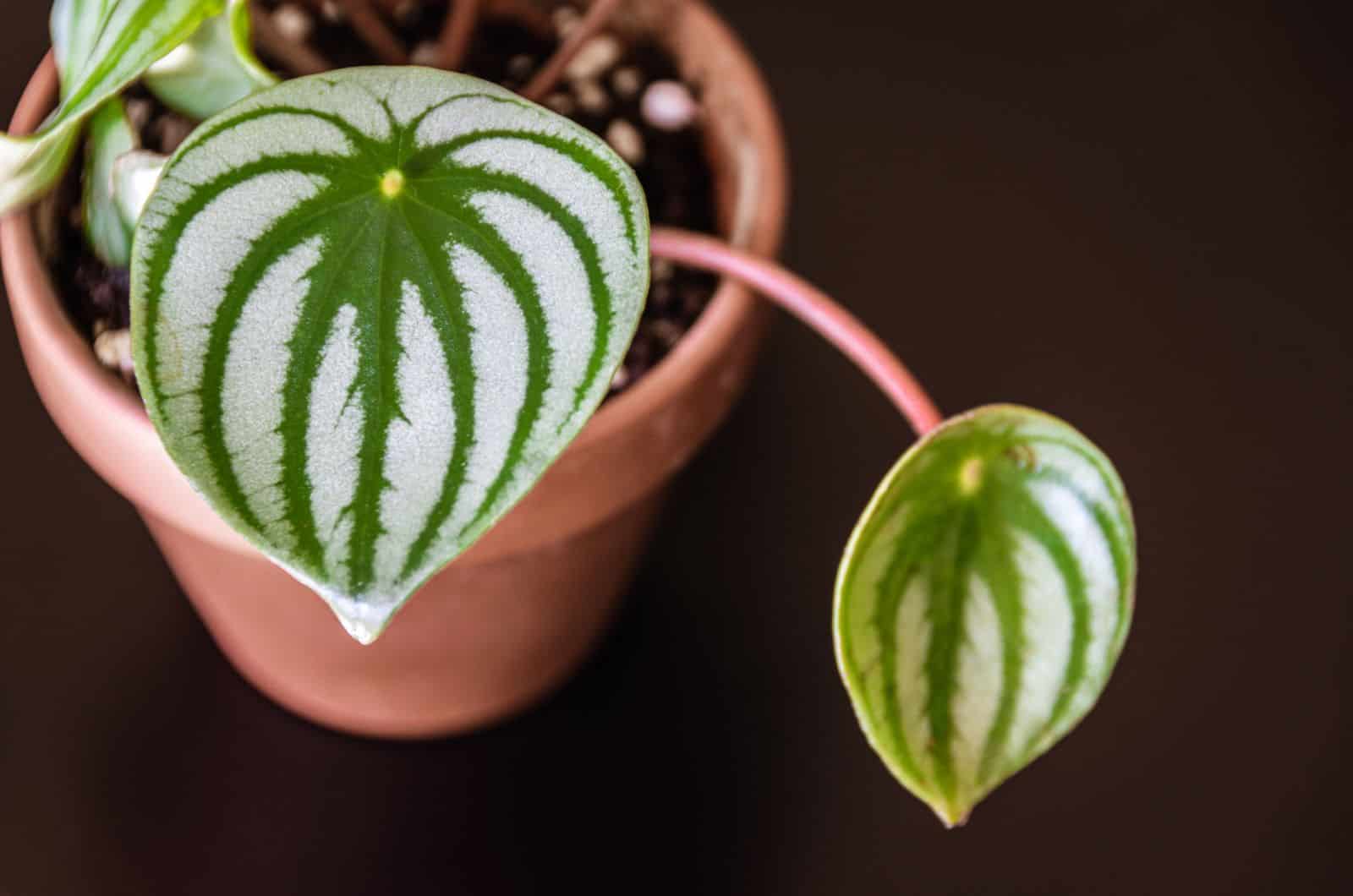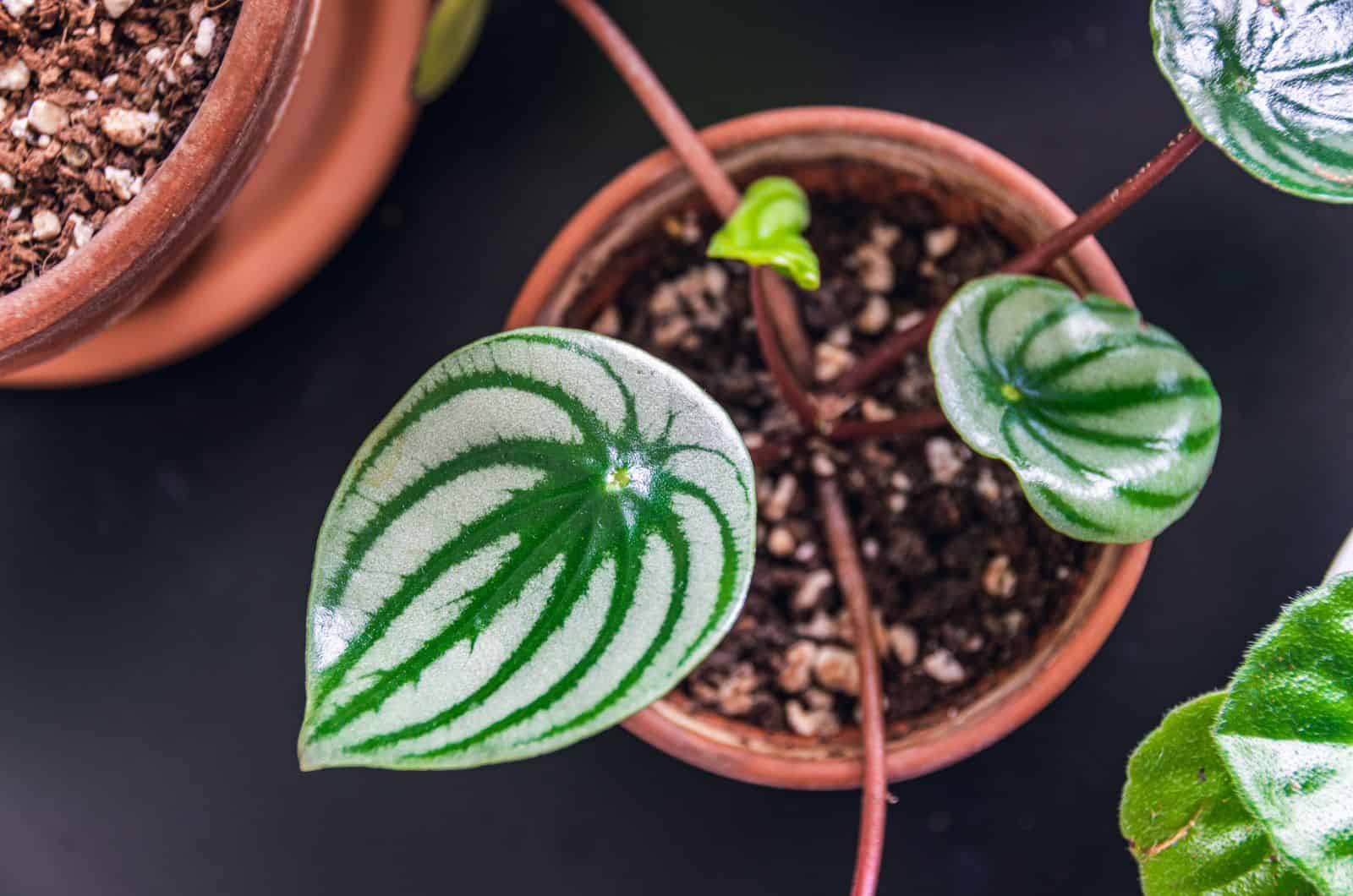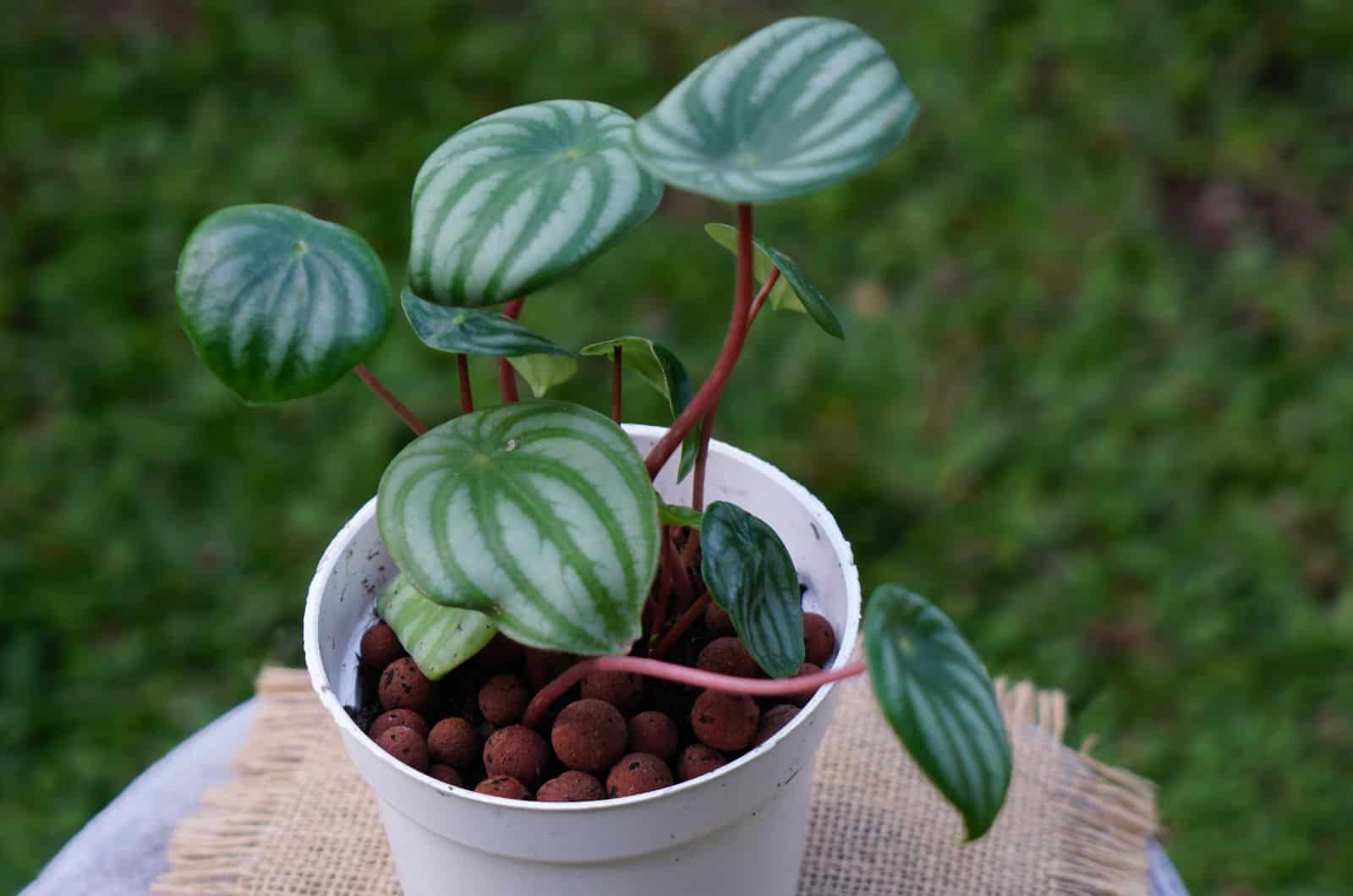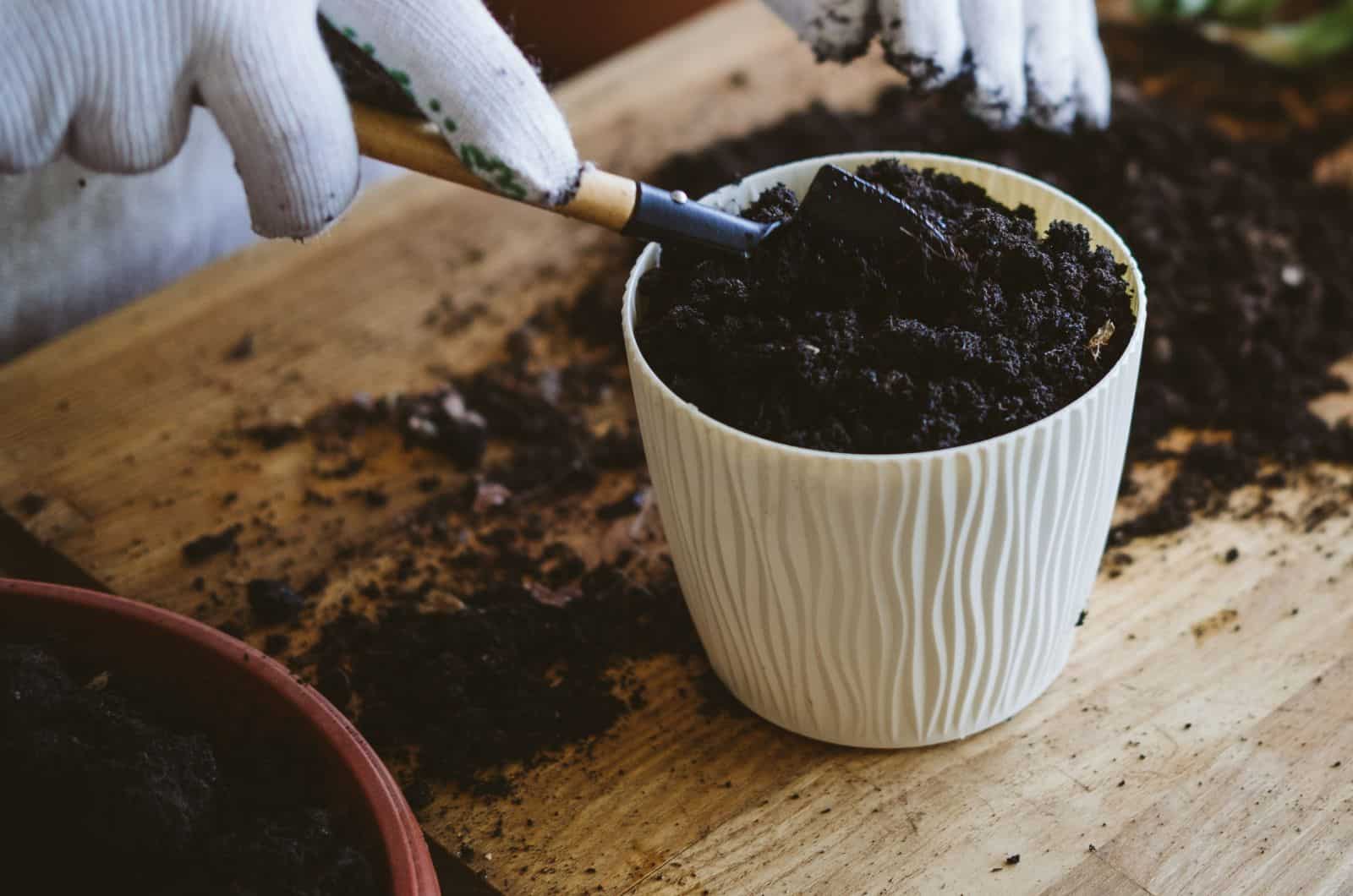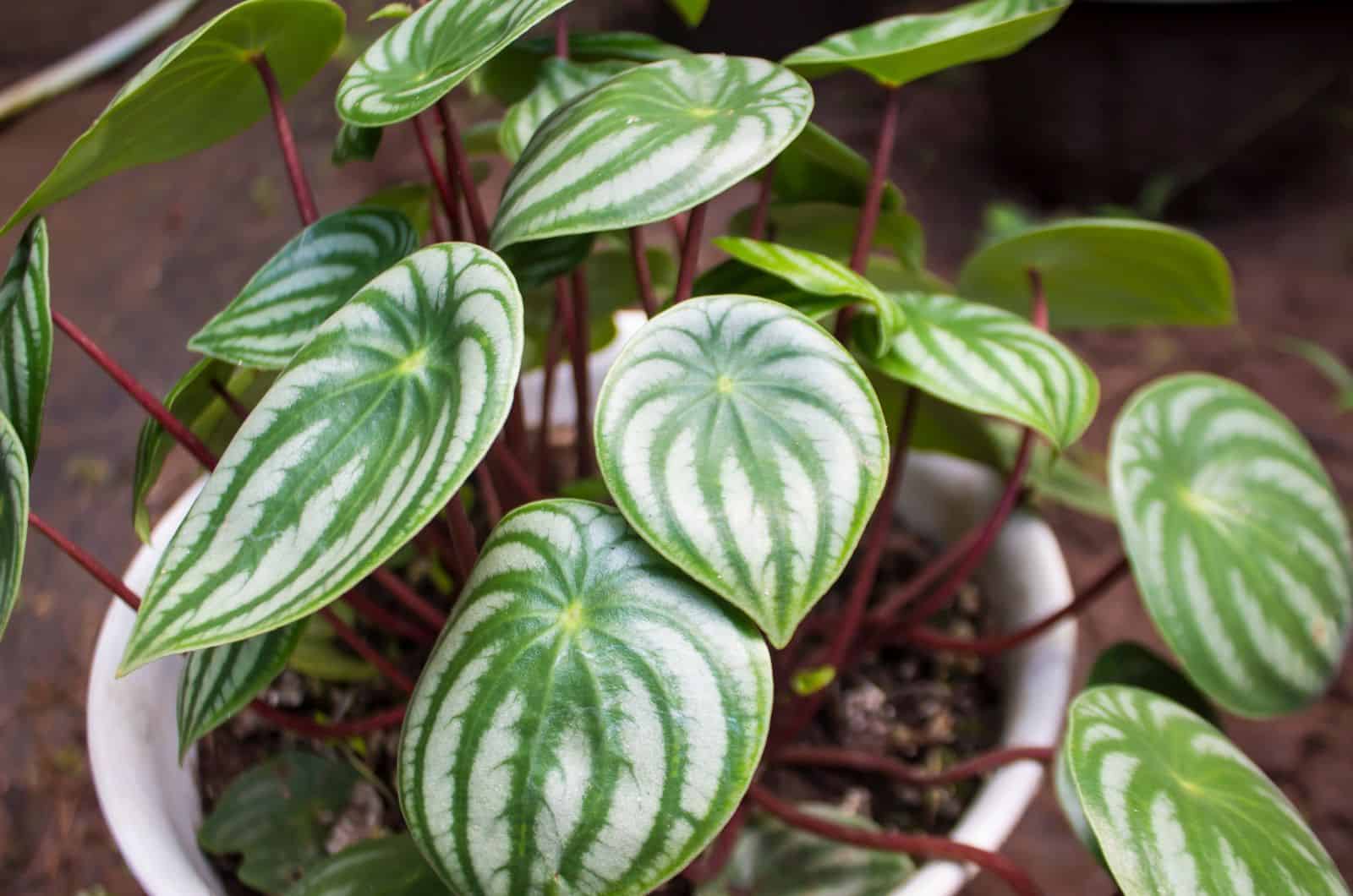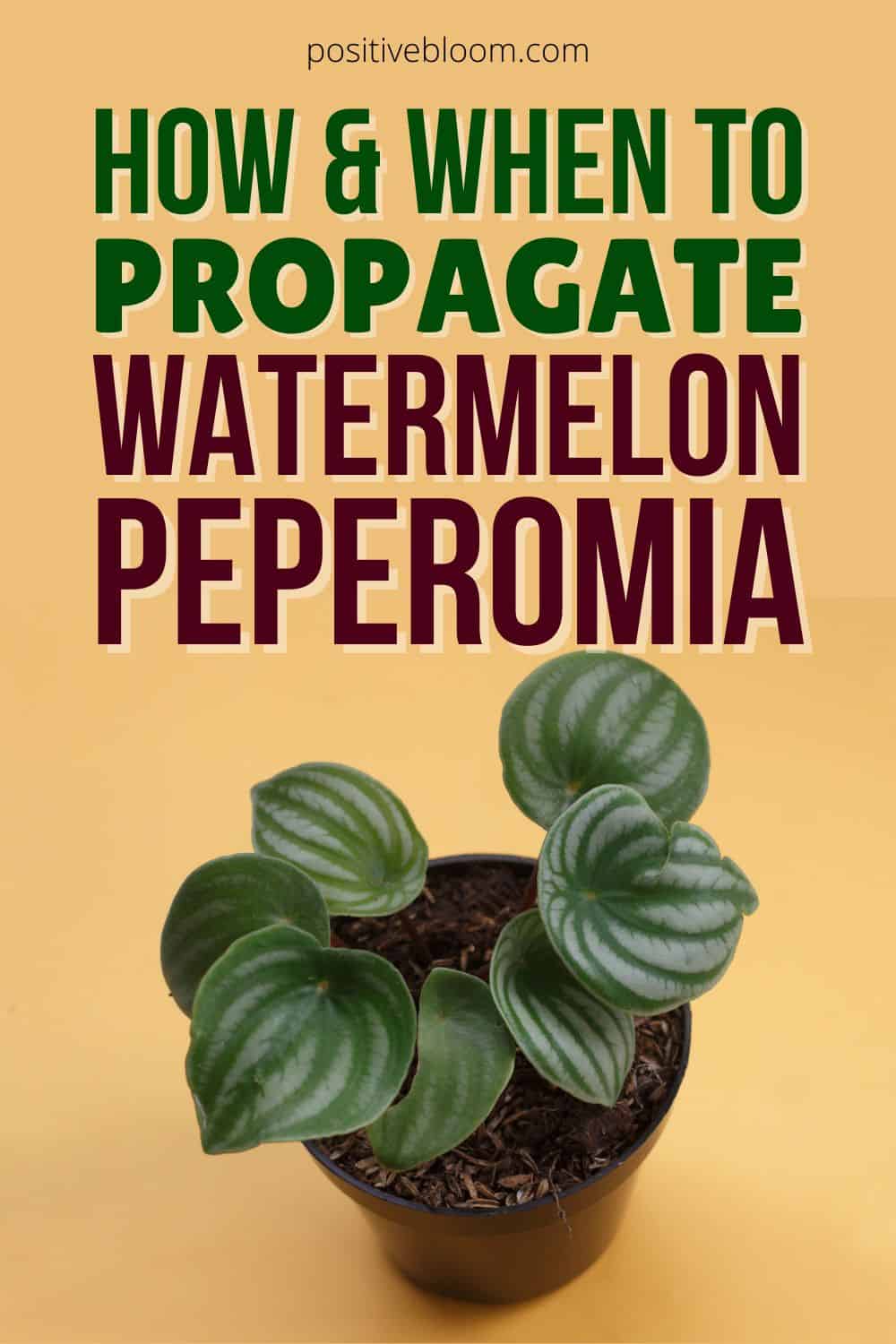When someone asks me why I am growing Peperomias, I simply say, “Have you ever seen a Peperomia?”
This especially relates to watermelon Peperomia, an amazing plant whose leaf pattern resembles a watermelon, hence the name.
This is a pretty small plant, and its compact growth habit makes sit perfect for smaller areas.
Additionally, these houseplants are easy to maintain and are non-toxic to humans and pets.
Now that you know why I grow Peperomias, I’m sure you’ll want many of them yourself. So, how and when do you propagate watermelon Peperomia?
Don’t worry, I’ll show you everything; including what and what not to do and how long it takes to propagate this plant.
Here’s some basic info about the watermelon Peperomia!
[table id=306 /]
Let’s get started!
How To Propagate Watermelon Peperomia
If you want to get more of these cute and low-maintenance plants, you can propagate them through stem or leaf cuttings.
Both methods have a high success rate. I’m sure you’ll be able to quickly grow new watermelon Begonia, even if you are a beginner grower.
Let’s find out everything you need to know!
Propagation By Stem Cuttings
Many plant growers choose to use the stem cutting propagation method for many reasons.
First, the chances of failing are low, second, it doesn’t take much time to do, nor do you have to wait too long for the Peperomia cuttings to develop roots, and finally, it’s interesting.
Let’s see what you need to do!
What To Prepare Before Propagation
It’s not a good idea to start propagating until you’ve prepared all the equipment you’ll use for the process. Trust me, it saves nerves and time!
Of course, the first thing to prepare is the plant itself. Remember that your plant needs to be completely healthy, including its root system.
You’ll need to do some cutting, so, you’ll need a perfect cutting tool. You need to pay attention to two factors when it comes to the tool. The first is the tool type; there are many options, such as pruning shears, knives, or scissors.
Bear in mind that this Peperomia variety doesn’t grow much in width or height, so the tool needs to be small. I use scissors as it’s easier for me to handle the plant and the tool simultaneously.
The next thing to consider about the cutting tool is that it needs to be sharp. If your cutting tool is blunt, you can damage your precious Peperomia.
You’ll also need a new pot; a two-inch pot made of plastic will work perfectly. Also, prepare the rooting medium; a glass, jar, or transparent vase will work just fine.
A rooting hormone will promote root sprouting, so consider getting one. However, it’s optional, just like gloves. If using gloves, pay attention to their size and material.
Finally, prepare something to sterilize the equipment, such as bleach or rubbing alcohol. To finish, prepare the appropriate potting mix and a plastic bag.
How To Take Watermelon Peperomia Plant Cuttings
When selecting a cutting you’ll propagate, make sure it’s completely healthy and has a node (at least one).
Remember, if there are any damaged parts on the cutting or if the cutting is wilting or drooping, the process won’t succeed.
As mentioned, the watermelon Peperomia plant doesn’t grow much. Still, the cutting needs to be long, so I recommend cutting a few inches from the stem.
The little part below the node is where you need to make a cut.
The cutting will have some leaves attached, and if you decide to root the cutting in water, you’ll need to remove the lower leaves so that they don’trot.
How To Root The Cuttings In Water
Although rooting the cuttings in water isn’t rocket science, a few things do need to be considered.
First, the glass, jar, or vase must be clean and narrow, so that the upper part of the cutting will stay above the water.
The second thing is the type of water you’ll use. Peperomias are sensitive to chlorine and fluoride, and as these two are commonly found in tap water, I don’t recommend using that water type.
Rainwater or filtered water are preferred for rooting the cuttings.
Now it’s time to immerse the bottom part of the watermelon Begonia cutting. Please don’t cover the cutting with a plastic bag right now; it does raise the humidity, but a combination of water evaporation and humidity isn’t good at this point.
Water in the rooting medium may get dirty, especially if there are some rotten parts. The best option is to refresh the water every three days.
How To Plant The Cuttings In Soil
Many skip rooting the cuttings in water, and if you decide to skip this step too, I’ll now explain how to root the cuttings directly in soil.
It helps if you first buy a pot; choose one like I mentioned above. After that, fill the container with the prepared potting soil. You can buy ready soil mix, but please add perlite, orchid bark, or pumice to promote water drainage.
However, you can also create your own blend by mixing equal parts of peat moss and perlite. There is no immediate need to add fertilizer.
Presoaking the soil will make it simpler to insert the cutting, thus, the next step is to do so. Additionally, you must create a hole in the potting soil.
The following steps also refer to planting cuttings previously submerged in water that have developed new roots.
The watermelon Peperomia cutting should now be dipped in a rooting hormone. Insert the cutting slowly into the hole, then top it up with extra potting soil to keep it firmly in place.
Water the soil, but be careful not to overwater it because you don’t want to kill it before it forms roots.
Until you see new growth, you must keep the soil moist. I advise spraying the cutting and enclosing it in a plastic bag. Don’t forget to periodically uncover it.
Where To Place The Cutting
Your cutting needs a particular light level to grow healthy roots, regardless of your rooting technique.
Peperomias are not exposed to direct sunlight in their natural environment, despite being tropical plants.
This is crucial for new plants because exposure to direct sunlight can result in sunburns or sometimes even death.
The watermelon Begonia cutting should be placed in indirect light. Finding a location with the ideal light level may be difficult for a beginner. Still, there are several tips and tactics that can assist you.
Even though you can put the cutter close to any window, some locations are preferable to others.
For instance, north-facing windows don’t receive enough light, and south-facing windows receive too much.
So, windows that face east or west will work well because in the mornings, they tend to have a lot of bright sunlight, which your Peperomia will benefit from. For the rest of the day, it will receive indirect sunlight.
How Long Does It Take To Propagate Watermelon Peperomia Through Stem Cuttings?
Bear in mind that the time that the roots need to sprout depends on the conditions you provide. Generally, you can expect Peperomia argyreia new roots in a month.
Sometimes, they may appear only two weeks after rooting, but they may also take longer than a month.
This is why I suggest rooting the Peperomia cuttings in water before planting them in the soil. The rooting medium is transparent, so you can see when new roots appear and if they have developed healthily.
But, if you ensure warmer temperatures, higher humidity, and indirect light, you’ll get a new plant pretty quickly.
Propagating Peperomia Argyreia Through Leaf Cuttings
Leaf cuttings propagation is becoming a prevalent method for getting new watermelon Peperomias.
The great thing is that there are a few very efficient methods for growing the plant from healthy leaf cuttings.
The first one is removing the entire leaf together with the petiole and planting it in the soil (the roots will sprout from the red leaf stem).
Also, splitting a leaf in half and then placing the portions in the ground is a great way to get baby plants.
Both will have a positive outcome, but if you decide to use the leaf without cutting it in half, you can expect the roots to sprout faster.
To clarify, non-variegated peperomia cultivars are the only ones that can be propagated through leaves. They are the ones with uniformly colored leaves.
Never root watermelon peperomia leaf cuttings in water, as they are susceptible to leaf rot.
How To Take Leaf Cuttings
If you decide on watermelon peperomia propagation using the whole leaf method, you’ll need a petiole to bury in the soil.
The leaf doesn’t need a petiole if you intend to cut it in half.
Before cutting, sterilize the tools to avoid transferring potential diseases to the mother plant.
Now, you can immerse the tips of the cut leaf in a rooting hormone.
How To Root The Cuttings
Fill a small pot with a soil mix; you can use larger pots if you intend to propagate more leaves. But, the pots shouldn’t be too large because leaves cut into halves won’t require much room.
Now you should put the cut side you dipped in a rooting hormone into the soil.
If you want to propagate more leaves, arrange them in a straight line in a pot. Make sure the cuttings are spaced apart sufficiently.
After that, you need to moisten the soil as the new roots will need water to grow.
It helps if you improve humidity levels—which promote the growth of the cuttings—by putting a plastic bag over the cutting.
It will capture the moisture that evaporates from the soil and make the area around the cutting more humid, which promotes rapid growth.
Apart from higher humidity, the cuttings will need bright indirect light to form roots.
Here is a video to show propagating Peperomia argyreia through leaf cuttings
How Long Does It Take To Propagate Watermelon Peperomia Through Leaf Cuttings?
The leaf cuttings may also take 2 to 4 weeks to develop new roots. Also, the mother plant will start growing new leaves from the parts you cut it.
Again, the time needed for the development of new watermelon peperomia roots depends on the conditions you ensure.
If it takes longer for new growth to appear, check the overall health of the cutting and whether all requirements are being met regarding light, humidity, and temperature.
When To Propagate Watermelon Peperomia
The propagation results also depend on the time of year you start propagating.
Watermelon peperomia begins its growing season in the early spring and will grow until the beginning of fall.
If you want to get baby plants, you should take the cuttings at the beginning of the growing season.
Your Peperomia will show new growth, and the cuttings will form new roots sooner. This is crucial because the roots are also less prone to root rot.
Additionally, these Peperomias should be repotted in spring, so why not take the cuttings then and avoid getting your hands dirty again?
Winter is a time of rest for Peperomia plants, and this period is referred to as dormancy. Since there is little active growth at this time, the roots are less likely to sprout.
The Benefits Of Propagation
Growers choose to grow Peperomias for many reasons, and getting a new Peperomia plant is always a great idea.
Let’s find out the benefits of propagating watermelon Peperomias!
Filters The Air
Based on NASA research, Peperomias can filter out airborne pollutants that are harmful to our health.
So, if you cultivate watermelon Begonias, the levels of toxic substances, like formaldehyde and carbon dioxide, will decrease.
These indoor plants are considered non-toxic, so if you decide to add more of them, you can place them anywhere, as there is no danger if your curious toddlers or pets chew on some leaves.
Makes A Wonderful Gift
Gifting a watermelon Begonia seems like a terrific idea!
Even if your friends aren’t very into growing plants, I’m sure they’ll start growing them once they realize the beauty and benefits of Peperomia plants.
The fact that these plants are easy to maintain makes the idea of gifting them even better.
So, instead of buying pretty expensive flower bouquets, why don’t you multiply your Peperomia and gift it to your loved ones?
It’s Affordable
Yes, you read it right! When you propagate plants, you are actually saving a lot of money. If you don’t believe me, do some research online.
For example, check out the price of plants on Amazon, and I’m sure you’ll be even more interested in creating new plants yourself.
Even though some tools for indoor plants may seem expensive, bear in mind that most of them last for a long time, especially if they are high-quality.
It Can Save The Plant
Saving plants by propagating them doesn’t refer to making diseased plants healthy but rather getting new plants that will grow and be just as beautiful.
If your plant has suffered from root rot or similar conditions, you’ll also now know what to avoid and how to keep propagated plants healthy.
Remember that many hybrids are created via propagation, and endangered species are saved this way, so there’s no reason not to propagate.
Common Mistakes When Propagating
There are several issues connected to the multiplying process that you should know about.
The first one is the rooting of leaf/stem cuttings. This issue arises frequently and mainly affects the cuttings you have been starting in the water.
Why? Stagnant water sounds like a perfect home for harmful fungi, which are responsible for rotting. If the water is muddy, brown, and smells unpleasant, something is wrong with the cutting.
So, always refresh the water in the rooting medium, even if it seems fine.
If parts of the watermelon peperomia cuttings rot, you should take the cutting out, clean and disinfect it, and submerge it in the water again.
Light intensity is another frequent problem; if the cutting is even briefly exposed to direct sunlight, the young leaves will turn pale. On the other hand, keep the cutting out of low light, as it dramatically reduces the root formation likelihood.
So, be patient and regularly check on the cuttings. I’m sure you’ll get a healthy and happy watermelon Peperomia soon.
Watermelon Peperomia Care Guide After Propagation
Your Peperomia will keep growing healthily and soon reach its full size if you meet all its requirements.
I mentioned a few times that this is a low-maintenance plant, so it’s time to find out about the right conditions for a watermelon Peperomia.
Let’s start!
Light Requirements
When compared to other indoor plants, watermelon Begonia may ‘survive’ shorter periods of direct sunlight exposure.
However, if you don’t provide it with indirect light most of the time, the plant will most likely suffer from sunburns.
On the other hand, this Peperomia doesn’t grow well in low light. If you notice that the plant has become leggy or is drooping, you should check the light level.
Temperature And Humidity
This Peperomia requires the same temperature and humidity conditions as other Peperomia cultivars such as Peperomia caperata.
When it comes to temperatures, they should be kept in the range of 60 to 80 degrees Fahrenheit. Although this Peperomia may grow well in slightly lower temperatures, I highly recommend keeping it away from temperatures below 50 degrees Fahrenheit.
High humidity is essential for propagated plants until they are fully established. Then, you’ll need to keep the humidity at around 50%.
It may be a little bit tricky to ensure such humidity, as it’s typically around 30% in homes. You can use a humidifier, pebble tray, or group your plants together. If you grow Monsteras, for example, it’s a great idea to place them near Peperomias.
Soil Requirements
This Peperomia prefers well-draining soil, but I don’t recommend using succulent potting mixes. Even though they are well-draining, they don’t retain enough water.
Therefore, you need a combination of well-draining materials that retain water well. You can mix perlite and peat moss to get the perfect soil type.
Also, Peperomias are plants that love acidic soil, so try keeping the pH between 6.0 and 6.6.
Watering Schedule
Watermelon Peperomia likes moist soil, so you shouldn’t let the soil dry out completely, but rather allow the top few inches to dry and then water it.
Why? Peperomia plants are prone to root rot from overwatering, so don’t water wet soil.
On the other hand, underwatering will cause the plant to droop, wilt, or develop yellow leaves.
Also, water your Peperomia more during summer because of the higher temperatures and its active growth. Reduce watering as soon as the winter approaches, as your plant will take a rest from growing.
Fertilizing
When it comes to watermelon Peperomia plant care, bear in mind that you shouldn’t skip fertilization.
I recommend feeding your Peperomia twice a month during the growing season and using a liquid and balanced fertilizer.
Repotting
Luckily, you don’t need to repot watermelon Begonia often; every two to three years should suffice. When repotting, choose a slightly larger container with many drainage holes.
If you notice Peperomia roots are growing out of the drainage holes, it’s time for repotting.
Take your Peperomia out of the pot, and remove as much soil as you can so that the root system is entirely visible.
If there are some discolored roots, cut them off with sanitized scissors. Put your Peperomia in a new container filled with fresh soil mix.
Common Issues
The most common issues for this Peperomia plant are related to pests, diseases, watering, and light issues.
Mealybugs often occur on the watermelon Peperomia leaves; remove them by rubbing neem oil on the leaves.
Root rot disease will occur if you constantly add more water until the roots suffocate.
You may also notice leaves curling, drooping, or wilting if your Peperomia lacks water.
The plant may get leggy or develop sunburns if it doesn’t receive enough light or receives too much.
The best option is to inspect your Peperomia regularly to spot any issues quickly.
FAQs
What does a Watermelon Peperomia look like?
Watermelon peperomia features glossy green and silver marked leaves. The stems of this Peperomia are short and come in a burgundy color.
This Peperomia produces stunning green flower spikes during its growing season.
Can you grow peperomia from a cutting?
Yes, you can grow Peperomia plants from cuttings. You can either use stem or leaf cuttings. Both methods will give great results if all steps are done correctly.
When it comes to stem cuttings, you can root them in water or directly in the soil, but leaf cuttings can’t be propagated in water.
Wrapping Up
Peperomias are the perfect houseplants for you if you are a beginner grower.
Now you also know how to propagate watermelon Peperomia, so you can have more of them or gift at least one to your friends.
Trust me, it’s an interesting and fun activity. If you use our care tips, your new watermelon Peperomia(s) will be healthy and thrive!
Until next time!
Like this pin? Share or pin it for later!

